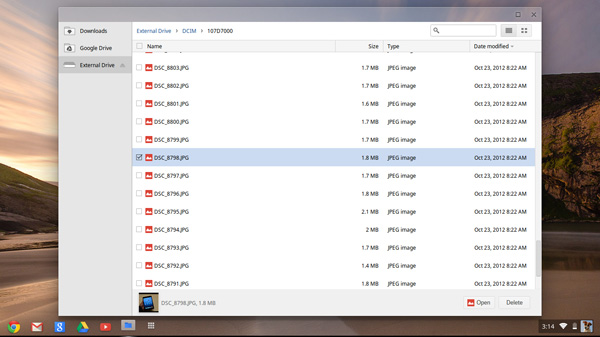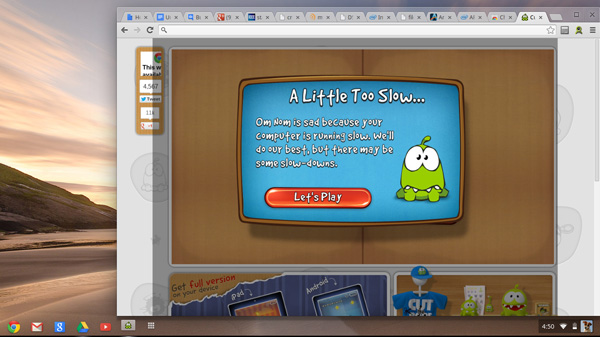Samsung Chromebook (XE303) Review: Testing ARM's Cortex A15
by Anand Lal Shimpi on October 31, 2012 9:00 AM ESTUser Experience & Usability
Similar to our performance analysis in the Surface review, there are really two sides to the performance of a Chromebook. There's the user experience as well as what the underlying hardware is capable of. I'll start with the user experience.
Chromebooks have never been all that robust when it comes to user experience. When Google first announced them they didn't even support mounting USB storage, although that has since been rectified. Although Google may have grand visions for where Chrome OS could go, today it serves one real purpose: to provide an affordable platform for a good web experience free of viruses and malware. To that end, the new Chromebook accomplishes its goal fairly well - as did the devices that came before it.
Chrome tends to be my favorite browser, and the experience maps fairly well the Chromebook platform. Web pages render properly and quickly (given the hardware that is). Compatibility isn't an issue. Everything just seems to work.
Obviously a major selling point of Chrome OS is that the web now allows for many content rich applications to be delivered directly in the browser rather than through a standalone executable. Google helps give access to these applications through the Chrome Web Store, although it's important to note that not all of them will run on the ARM based Chromebook (nor is there a good listing of those that will/won't run). The apps themselves vary in type from simple games to productivity tools. Many are quite functional, but the performance just isn't very good compared to a $500 tablet or even a $500 PC.
Technically the Chromebook can do a lot, but for anything other than browsing, YouTube and Google docs use I wouldn't get my hopes up. The heavier apps just don't run smoothly on the platform. Even web browsing isn't what I'd consider fast, but it's still acceptable. To put things in perspective, I got a performance warning trying to play Cut the Rope on the new Chromebook. Stability can also be a problem. Try to deviate too much from normal web browsing and you'll be greeted with long pauses and even system locks. For example, while testing WebGL performance on the new Chromebook I had to power cycle the machine after the browser became unresponsive. Normal web browsing is fine though.
There are other annoyances that aren't strictly performance related. For example, Netflix streaming won't work on the new Chromebook. Although image browsing support is native to the OS, there's no support for RAW camera files from a DSLR.
For the basic necessities however, the Chromebook does embody the fast enough computing concept. I researched, wrote and did almost all of my work while preparing this review on the Chromebook and generally found the experience acceptable. Other features like Pandora worked just fine (although I'd occasionally get hiccups in music playback if I loaded a particularly complex page). Whenever I'd switch back to my Ivy Bridge notebook I'd really appreciate the extra speed, but for writing and web browsing duties the Chromebook got the job done. Had Chrome OS been built around a lesser browser I don't think I would be as positive about the experience.












149 Comments
View All Comments
Krysto - Thursday, November 1, 2012 - link
Tablets and phones don't boot-up instantaneously. That's waking from idle mode that you're talking about, which basically just means turning on the screen.Krysto - Wednesday, October 31, 2012 - link
When Cortex A7 arrives in big.Little I expect the idle times to drop dramatically in A15 set-ups, and I doubt Intel can keep up with that. Not to mention they still won't keep up in graphics department.Anand, can you stop plugging Surface into Android and Chromebook reviews? Why would I want to hear how Surface might do in the future with this chip that Chromebook already has? Seriously.
Exophase - Wednesday, October 31, 2012 - link
Anand's Cortex-A15 diagram looks really weird vs an official one.. http://regmedia.co.uk/2011/10/20/arm_a15_pipeline_...Three instructions are decoded and dispatched to 5 clusters of 8 execution queues (8 slots each) per cycle, then each cycle each execution queue can issue a cycle to its associated execution unit (note this diagram is using issue/dispatch opposite from how it's often used). There's no execution relationship like given in Anand's diagram, the clusters are: NEON (2x), load/store (2x), simple ALU (2x), multiply, and branch.
Anand Lal Shimpi - Wednesday, October 31, 2012 - link
I based my diagram on a lot of the content in here:http://www.arm.com/files/pdf/AT-Exploring_the_Desi...
Slide 20 introduces the independent issue queues, although subsequent slides make it all a bit more ambiguous (and more like the block diagram you included). I didn't include "issue" width for each of the arrows in my diagram to keep thing simple but I can see that it can definitely give the wrong impression.
Let me see about doing a better pass on the A15 once I'm back from my current trip.
Take care,
Anand
madmilk - Wednesday, October 31, 2012 - link
More proof that ARM ISA isn't magically more efficient than x86 in perf/watt.My i7-3720QM Mac can complete Kraken in 2100ms, with a load power consumption of 30W and idle power of 12W (display on at mid-brightness, discrete GPU off). Ivy has very good power gating, so I'll just assume the CPU is consuming 20W. This results in 42 Joules to complete one run of Kraken. The A15 on the other hand, with a differential of 4 watts (again assuming perfect gating at idle) takes 38.8 Joules. In server usage, perf/watt is king. If the best ARM can deliver is 10% better perf/watt at the expense of 5x per-core performance, they're not going to make a dent against Xeon. I imagine V8 could be optimized more for ARM, but the gains there are not nearly as big as before.
Some other observations -
I ran 8 instances of Kraken at once to make use of all the cores and HT, while reducing the effect of perf/watt-killing Turbo Boost. Power consumption was about 65W total, or approximately 55W going into the CPU. Each Kraken finished in about 3700ms, so what we have is 55W*3.7s/8 = 25 joules per Kraken. Much better, but obviously an apples-to-oranges comparison against the A15 which should probably have two instances run on it for optimal efficiency.
Also, shame on Intel/Samsung/Google for the Chromebook 500. 12W idling for a netbook is just ridiculous.
I don't think we can pull the 32nm vs 22nm fab card here either, because Intel has always been ahead in this respect and the gap is widening.
lemonadesoda - Wednesday, October 31, 2012 - link
The new chromebook is a near-winner! While it is targetting impulse purchase, low-budget buyers, and 2nd world economies, they should consider a 1st world premium buyer audience. If this had a better quality screen with "retina" pixel density, I would buy one in a heartbeat. I don't want to game... I want to read my PDFs without having to zoom to make the text legible... and with the SD card reader... it would be a perfect image display device for the SD cards once it comes out of the camera. 1366x768 is very 2009, not 2012.ol1bit - Wednesday, October 31, 2012 - link
I don't understand why Chrome OS continues at all?Just slapping JellyBean on this hardware would have much more functionality.
andrewaggb - Wednesday, October 31, 2012 - link
Only google can answer this question....Kinda like Firefox OS... or whatever they are calling it. Just not sure what the point is. Maybe they figured linux needs just a few more radically different distributions :-)
ssddaydream - Wednesday, October 31, 2012 - link
Please, will somebody ban this clown?ShaneMickey, that is...
ssddaydream - Thursday, November 1, 2012 - link
...there will be support that would allow AndroidOS, Linux, or Windows RT to be installed and properly functioning on this device.